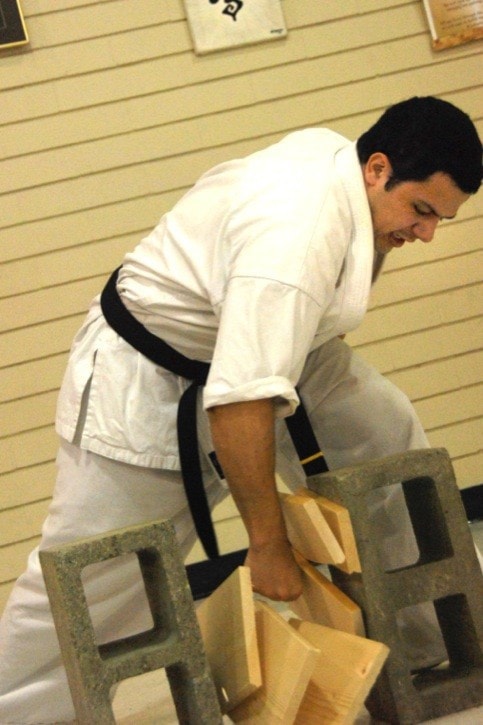Good things come to those who wait.
Those words hold such significance to Andre Gress, that he has them tattooed across his arm.
“But that is the type of guy he is,” explained his teacher, Sensei Leo van den Boogaard.
“I say it to him — ‘put your nose to the grindstone, don’t say anything and keep training, and good things will come.’”
“People want things, but they don’t always want to put the time in,” van den Boogaard added.
“I see this as an instructor because I have had well over a thousand students in my dojo and it is not for everybody.”
“He stuck with it and it is a real testament to him and his perseverance,” van den Boogaard said.
Van den Boogaard has been practising karate for 40 years and has run a Langley branch of the Mas. Oyama’s Kyokushin Karate out of the Douglas Park Recreation Centre since 1993. Prior to that, he ran a dojo out of Newton.
Van den Boogaard estimates that out of about every 1,000 students, one will successfully complete the required testing and be awarded their black belt.
But when Gress started the sport 15 years ago at the age of eight, aspiring to earn his black belt was not the goal. It was simply something his parents put him in in order to keep the Aldergrove child busy and active.
“It went from being an extracurricular activity that my parents encouraged me to do to being a lifestyle for me,” said Gress, who is now 23.
“This is something that has developed me as the person I am today.”
Kyokushin is a style of stand-up, full contact karate that has been practised since 1954. It is rooted in a philosophy of self-improvement, discipline and hard training.
But all of the time he has put into working towards his black belt, has been worth it.
“I knew one day I would get my black belt,” he said.
“It has been a journey. It’s something you have to be patient with, I understood the benefit of being absolutely ready for testing.”
The belt system sees a person begin as a white belt, then orange, blue, yellow, green, brown and then black.
There is a lengthy and stringent two-year process in going from a brown to the black belt.
The first step is a formal application, which must be sponsored by their instructor.
Each candidate must have a valid first aid and CPR certificate and a NCCP coaching certificate.
They must also attend a minimum number of winter and summer camps and have participated in certain official tournaments.
That wraps up the application process and next comes a winter camp in March where they write a formal exam, demonstrate their board-breaking ability — they must break seven to 10 boards using three different techniques (knife hand, elbow, kick, fist) — and then be interviewed by their superiors on why they are doing this.
The next step is a three-hour practical exam where they are tested on technical ability, physical strength — they must be able to do a minimum of 100 pushups, sit-ups, squats and perform a handstand — and then display their forms and kata.
The final leg of the exam consists of a summer camp where the candidates participate in special grading classes, and finish the camp with their respective sparring/knockdown fights.
Each degree of black belt must fight 10 other black belts or higher grades, for 90 seconds apiece, consecutively.
So Gress fought 10 as he was going for his first degree black belt. Going for his second degree would mean he fought 20, and so forth.
He passed his final test back in August, and received his official black belt at a special ceremony held at the Douglas Park Recreation Centre on Dec. 3.
Gress called the pursuit of the black belt a milestone in his life.
“It really made me value being patient and asking myself how badly did I want to do this,” he said.
Gress says his journey to the black belt has taught him quite a bit.
“There is more to it than just learning to fight in our style,” he explained.
“It is about valuing not just the things you have in life, but valuing yourself, what you are able to do do and how big of a drive you need to have.”
“I would say all of this has really disciplined me.”
Van den Boogaard has trained about six other black belts in his 20-plus years as an instructor, all of whom have gone on to open their own dojos.
Gress may very well open his own dojo one day down the road, but for the time being, he is focused on finishing his schooling.
Gress, who is studying in the creative writing program at Kwantlen Polytechnic University and aspires to be a screenwriter, wants to use what he has learned through karate to teach people about values.
